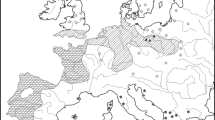Abstract
Soil samples were collected from the rhizosphere of faba bean (Vicia faba L.) in Khuzestan province, south-western Iran. Many of the localities were positive for the presence of Aphelenchus avenae. The morphological and morphometric characters of the two Iranian populations are discussed and illustrated based on morphological and morphometrics data. Additionally, sequences of the D2-D3 expansion segments of 28S rRNA gene for two populations were used for molecular phylogenetic analysis. One population was without male and formed a separate branch in the phylogenetic tree. Results indicate high genetic variation among A. avenae populations from different geographic regions.





Similar content being viewed by others
References
Alvani S, Mahdikhani Moghadam E, Rouhani H, Mohammadi A (2016) Species of superfamily Aphelenchoidea (Nematoda: Rhabditida) associated with (Crocus sativus, Berberis vulgaris, Ziziphus zizyphus) from South Khorasan province. J Plant Protect 30(2):261–269
Andrássy I (2007) Free-living nematodes of Hungary (Nematoda errantia). Vol. II. (Series Eds: Csuzdi C, Mahunka S). Budapest, Hungary, Hungarian Natural History Museum and Systematic Zoology Research Group of the Hungarian Academy of Sciences
Blaxter ML, De Ley P, Garey JR, Liu LX, Scheldeman P, Vierstraete A, Vanfleteren JR, Mackey LY, Dorris M, Frisse LM, Vida JT, Thomas WK (1998) A molecular evolutionary framework for the phylum Nematoda. Nature 392:71–75. https://doi.org/10.1038/32160
De Grisse AT (1969) Redescription and modification of some techniques used in the study of nematodes phytoparasitaires. Meded Rijks LandbouWeten Gent 34:351–369
Ghaderi R, Kashi L, Karegar A (2012) The nematodes of Iran, based on the published reports until 2011. Agricultural Education and Extension Publication, Tehran, Iran
Holovachov O, Camp L, Nadler SA (2015) Sensitivity of ribosomal RNA character sampling in the phylogeny of Rhabditida. J Nematol 47(4):337–355
Holterman M, van der Wurff A, van den Elsen S, van Megen H, Bongers T, Holovachov O, Bakker J, Helder J (2006) Phylum-wide analysis of SSU rDNA reveals deep phylogenetic relationships among nematodes and accelerated evolution toward crown clades. Mol Biol Evol 23(9):1792–1800. https://doi.org/10.1093/molbev/msl044
Hunt DJ (1993) Aphelenchida, Longidoridae and Trichodoridae: Their systematics and bionomics. CAB International, Wallingford
Huson DH, Scornavacca C (2012) Dendroscope 3: an interactive tool for rooted phylogenetic trees and networks. Syst Biol 61:1061–1067. https://doi.org/10.1093/sysbio/sys062
Jenkins WR (1964) A rapid centrifugal flotation technique for separating nematodes from soil. Pl Dis Reptr 48:692
Kim J, Lee SH, Gazi M, Kim T, Jung D, Chun JY, Kim S, Seo TK, Park C, Baldwin JG, Nadler SA, Park JK (2015) Mitochondrial genomes advance phylogenetic hypotheses for Tylenchina (Nematoda: Chromadorea). Zool Scr 44(4):446–462. https://doi.org/10.1111/zsc.12112
Kumari S (2012) Aphelenchus avenae (Nematoda: Aphelenchidae) under the rhizosphere of Brassica napus. Helminthologia 49(1):57–59. https://doi.org/10.2478/s11687-012-0009-y
Lagerlöf J, Insunza V, Lundegårdh B, Rämert B (2011) Interaction between a fungal plant disease, fungivorous nematodes and compost suppressiveness. Acta Agr Scand B - S P 61:372–377. https://doi.org/10.1080/09064710.2010.488655
Larget B, Simon DL (1999) Markov chain Monte Carlo algorithms for the Bayesian analysis of phylogenetic trees. Mol Biol Evol 16(6):750–759. https://doi.org/10.1093/oxfordjournals.molbev.a026160
Manzanilla-Lopez RH, Marban-Mendoza N (2012) Practical plant nematology. Editorial Colegio de Postgraduados, San Diego
Meldal BHM, Debenham NJ, De Ley P, De Ley IT, Vanfleteren JR, Vierstraete AR, Bert W, Borgonie G, Moens T, Tyler PA, Austen MC, Blaxter ML, Rogers AD, Lambshead JD (2007) An improved molecular phylogeny of the Nematoda with special emphasis on marine taxa. Mol Phylogenet Evol 42:622–636. https://doi.org/10.1016/j.ympev.2006.08.025
Mohammad Deimi A, Mitkowski N (2010) Nematodes associated with vineyards throughout Markazi province (Arak), Iran. Australas Plant Pathol 39:571–577. https://doi.org/10.1071/AP10044
Nadler SA, De Ley P, Mundo-Ocampo M, Smythe AB, Stock SP, Bumbarger D, Adams BJ, De Ley IT, Holovachov O, Baldwin JG (2006) Phylogeny of Cephalobina (Nematoda): molecular evidence for recurrent evolution of probolae and incongruence with traditional classifications. Mol Phylogenet Evol 40:696–711. https://doi.org/10.1016/j.ympev.2006.04.005
Nunn GB (1992) Nematode molecular evolution. Dissertation, University of Nottingham, Nottingham
Nylander JAA (2004) MrModeltest v2. Evolutionary Biology Centre, Uppsala University. Available from: http://www.ebc.uu.se/systzoo/staff/nylander.html. Accessed 14 April 2014
Okada H, Kadota I (2003) Host status of 10 fungal isolates for two nematode species, Filenchus misellus and Aphelenchus avenae. Soil Biol Biochem 35(12):1601–1607. https://doi.org/10.1016/j.soilbio.2003.08.004
Pedram M, Pourjam E, Ye W, Atighi MR, Robbins RT, Ryss A (2011) Description of Bursaphelenchus mazandaranense sp. n. (Nematoda: Parasitaphelenchidae) from Iran. Russian. J Nematol 19:121–129
Ronquist F, Huelsenbeck JP (2003) MrBayes 3: Bayesian phylogenetic inference under mixed models. Bioinformatics 19(12):1572–1574. https://doi.org/10.1093/bioinformatics/btg180
Thorne G, Malek RB (1989) Nematodes of the northern Great Plains. South Dakota state University, Brookings
Van Megen H, Van Den Elsen S, Holterman M, Karssen G, Mooyman P, Bongers T, Holovachov O, Bakker J, Helder J (2009) A phylogenetic tree of nematodes based on about 1200 full-length small subunit ribosomal DNA sequences. Nematology 11(6):927–950. https://doi.org/10.1163/156854109X456862
Acknowledgments
The author gratefully thanks Dr. Irma Tandingan De Ley (Department of Nematology, University of California, Riverside, USA) for providing some useful articles and the Shahid Chamran University of Ahvaz for financial support.
Funding
This study was funded by Shahid Chamran University of Ahvaz (grant number 1276).
Author information
Authors and Affiliations
Corresponding author
Ethics declarations
Conflict of interest
No potential conflict of interest was reported by the author.
Rights and permissions
About this article
Cite this article
Azimi, S. Morphological and molecular characterization of two populations of Aphelenchus avenae (Nematoda: Aphelenchidae) from Iran and their phylogenetic relationships. Biologia 73, 683–691 (2018). https://doi.org/10.2478/s11756-018-0079-5
Received:
Accepted:
Published:
Issue Date:
DOI: https://doi.org/10.2478/s11756-018-0079-5




